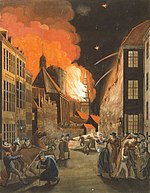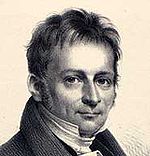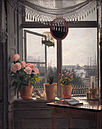Danish Golden Age
The Danish Golden Age (
It also saw the development of
In relation to
Background and context

The origins of the Golden Age can be traced back to around the beginning of the 19th century, which was a very rough period for
These events nevertheless provided new opportunities for Copenhagen. Architects and planners widened the streets, constructing beautifully designed Neoclassical buildings offering a brighter yet intimate look. At the time, with a population of only 100,000, the city was still quite small, built within the confines of the old ramparts. As a result, the leading figures of the day met frequently, sharing their ideas, bringing the arts and the sciences together.

Especially in the field of painting, change became apparent. While art had previously served to uphold the monarchy and the establishment, Christoffer Wilhelm Eckersberg and his students realized that, with the arrival of industrialization, the middle classes were increasingly gaining power and influence. Grand historical art gave way to more widely appealing but less pretentious genre paintings and landscapes.[4]
The main period of the Golden Age took place during the first half of the nineteenth century. Around that time, Danish culture suffered from the outbreak of the First Schleswig War (1848–1851) and then the Second one in 1864. In addition, political reforms involving the end of the absolute monarchy in 1848 and the adoption of the Danish constitution the following year signalled the beginning of a new era. Finally, the extension of Copenhagen beyond the old ramparts during the 1850s opened up new horizons for urban expansion.
It was not until 1890 that the Danish philosopher
Painting
Around the beginning of the 19th century, the Golden Age of Danish Painting emerged to form a distinct national style for the first time since the Middle Ages; the period lasted until the middle of the century. It has a style drawing on
A crucial figure was
An investigation of drawings, underdrawings, oil sketches and finished paintings by Eckersberg and his pupils Christen Købke and Constantin Hansen, using their Italian views as examples, points to a number of important aspects which shed light on the creative process in Danish Golden Age painting in the first half of the 19th century. The preliminary drawings – preferably composition drawings – which were done in front of the motif were meticulously constructed and reproduced many details. Architecture received the painters' greatest attention, whereas vegetation, rocks and stones as well as figures in the landscape received a lower priority. The drawing done directly from the motif was squared up in several instances with a view to its transference to the painting, which was often no larger than the drawing. Some elements could be altered during the process, but by and large the artist retained the original dispositions quite precisely. In some cases the architecture was consciously altered so as to strengthen the forms and create harmony in the picture. In this way, we can prove that although the Italian motifs appear realistic at first sight, they were nonetheless adjusted or even manipulated by the artists.[10]
Prominent artists of the Danish Golden Age of Painting included
At the end of the period painting style, especially in landscape art, became caught up in the political issue of the
Landscape painting
The art historian Niels Laurits Høyen who taught at the Academy encouraged his students to turn to landscape painting. Johan Thomas Lundbye, Christen Købke, P. C. Skovgaard, Dankvart Dreyer, Louis Gurlitt and Martinus Rørbye were among those who developed a new approach to the genre, concentrating on scenes from the Danish countryside.[12]
-
Hankehøj by Johan Thomas Lundbye (1847)
-
Møns Klint by Louis Gurlitt (1842)
-
The beach at Skagen Vesterby by Martinus Rørbye (1847)
-
View over Vejle by P. C. Skovgaard (1852)
Genre painting and portraits
A new type of genre painting also emerged during the Golden Age. Interiors depicting the middle and upper classes in the right settings were a favorite motif. Portraits followed the same pattern.[13]
-
View from the Artist's Window by Martinus Rørbye (1825)
-
Interior on Amaliegade by Wilhelm Bendz (1826)
-
Model class at the Danish Academy by Wilhelm Bendz (1826)
-
Portrait of Frederik Sødring by Christen Købke (1832)
Sculpture
Other contributors to sculpture in the Golden Age include Hermann Ernst Freund, whose work centred on Scandinavian gods, and Herman Wilhelm Bissen, who sculpted contemporary figures such as Landsoldaten (The Foot Soldier), a victory monument to the war of 1848–1851.[14]
-
Jason with the Golden Fleece by Bertel Thorvaldsen (1802–03)
-
The Lion Monument by Bertel Thorvaldsen (1819)
-
Statue of Christ in Copenhagen Cathedral by Berthel Thorvaldsen (1838)
-
The Foot Soldier by Herman Wilhelm Bissen (1858)
Architecture
During the Golden Age, Copenhagen in particular acquired a new look as architects inspired by neo-classicism repaired much of the damage caused by fire in 1795 and by the British bombardment of the city in 1807.[15]
Building on the experience of C. F. Harsdorff in the late 18th century, the main proponent of Classicism in the Golden age was
In 1800, Hansen was also charged with rebuilding Christiansborg Palace which had burnt down in 1794. He worked with Gustav Friedrich Hetsch who completed the interiors. Unfortunately, the palace burnt down once again in 1884. All that remains is the magnificent chapel which, with its Ionic columns, conveys a sense of antiquity.[16]
Andreas Hallander and Johan Martin Quist were among those who rebuilt the houses in the older sections of Copenhagen which had been destroyed by fire.[18]
-
Colonnade atAmalienborg Palace (1794–1795) by C. F. Harsdorff
-
C.F. Hansen(1813–26)
-
Copenhagen Court House (1815), designed by Christian Frederik Hansen
-
Michael Gottlieb Bindesbøll(1838–48)
Music and ballet

The 19th century also saw the emergence of a number of Danish composers who were inspired by Romantic nationalism.
Hans Christian Lumbye (1810–1874) was employed as the first music director at the Copenhagen amusement park Tivoli when it opened in 1843. Here he had a platform for presenting a large foreign and Danish repertory, including his many waltzes and gallops. In 1839, he had heard a Viennese orchestra play music by Johann Strauss, after which he composed in the same style, eventually earning the nickname "The Strauss of the North".[20] One of his most popular pieces, associated with Tivoli, is Champagnegaloppen (the Champagne Galop), which starts with the happy sound of a champagne cork popping. It has been used in several Danish films including Reptilicus (1961), and Champagnegaloppen (1938).

A second generation of significant composers of this period include Peter Heise, Emil Hartmann, Asger Hamerik, August Winding or C.F.E. Horneman.
Ballet
A major contributor to the ballet scene during the Golden Age was
Literature and philosophy
- Literature
During Denmark's Golden Age, literature centred on

One of the most important figures in Danish literary culture was

Hans Christian Andersen (1805–1875) is remembered first and foremost for his fairy tales, written between 1835 and 1872 not only for children but for adults too. Among the most popular are "The Steadfast Tin Soldier", "The Snow Queen", "The Little Mermaid", "Thumbelina", "The Little Match Girl", and "The Ugly Duckling". Considered to be the father of the modern fairytale, Andersen wrote a total of 156 fairy stories, only 12 of which drew on folk tales. But Andersen also wrote a number of travel sketches, several novels including the well-received: "The Improvisatore" (1835), a series of poems, and his autobiography "The Fairy Tale of My Life" (1855).[28]
- Philosophy
Danish philosophy was dominated in the first half of the 19th century by the influence of Hegel and Hegelianism.
Science

One name stands out above all others among those who contributed to science during the Danish Golden Age, that of Hans Christian Ørsted, the prominent physicist and chemist known for observing that electric currents induce magnetic fields, an important aspect of electromagnetism. He shaped post-Kantian philosophy and advances in science throughout the late 19th century.[31]
In 1824, Ørsted founded Selskabet for Naturlærens Udbredelse (SNU), a society to disseminate knowledge of the natural sciences. He was also the founder of predecessor organizations which eventually became the Danish Meteorological Institute and the Danish Patent and Trademark Office. Ørsted was the first modern thinker to explicitly describe and name the thought experiment. He was convinced that all things in the universe were related, both materially and spiritually. He described this in his philosophical work Ånden i naturen (The Spirit in Nature).[32]
Ørsted contributed strongly to the Golden Age, especially through his close friendship with Hans Christian Andersen.[32]
Impact
The leading players in the Danish Golden Age have not only had a lasting impact in Denmark, but throughout the world. Hans Christian Andersen's fairy tales have been translated into over 150 languages, more than any book apart from the Bible, and continue to be read to children everywhere.[33] With the exception of
In architecture, when designing the Thorvaldsen Museum, Michael Bindesbøll gave special attention to liberating the building from its surroundings. His free perception of space served as a guiding principle for the cities and buildings of the future.[34]
The choreographer, August Bournonville, resisting many of the excesses of the romantic era ballets, gave equal emphasis to male and female roles in his work at a time when European ballet emphasized the ballerina.
N. F. S. Grundtvig exerted considerable influence on education, promoting a spirit of freedom, poetry and disciplined creativity. Opposing compulsion and examinations, he advocated unleashing human creativity according to the universally creative order of life. A spirit of freedom, cooperation and discovery was to be kindled in individuals, in science, and in society as a whole. Søren Kierkegaard has also strongly influenced philosophy and literature right up to the present day. Among the many who have profited from his ideas are Jean-Paul Sartre, Niels Bohr and W. H. Auden.
Hans Christian Ørsted's scientific advances contributed fundamentally to chemistry, with his work on aluminium, and especially to physics, with his conclusive research on electromagnetism.[35]
Finally, many of the works of the painters and sculptors of the period continue to be exhibited in the world's finest museums and galleries. Some, like Christen Købke, have attracted renewed interest in recent years.[36]
References
- ^ Kulturnet Danmark, Guide to the Danish Golden Age Archived 2006-01-10 at the Wayback Machine
- ^ "Pengereformen, der blev kendt som statsbankerotten", Nationalbanken. (in Danish) Retrieved 30 August 2010.
- ^ a b "Historical overview", Guide to the Danish Golden Age Archived 2011-07-19 at the Wayback Machine. Retrieved 30 August 2010.
- ^ "Danish art before 1900" Archived 2011-07-20 at the Wayback Machine, Aarhus Kunstmuseum. Retrieved 30 August 2010.
- ^ Arkiv for Dansk Litteratur – Henrich Steffens – Forfatterportræt Archived 2011-07-16 at the Wayback Machine, (in Danish). Retrieved 30 August 2010.
- ^ Dutch paintings, and landscapes, dominated in the 18th century Danish collections that we have records of. North, 308-9 [1]
- ^ Christoffer Wilhelm Eckersberg. From National Gallery of Art. Archived 2010-04-08 at the Wayback Machine Retrieved 3 November 2009.
- ^ Boime, 504-5
- ^ Visual Arts from Danish Ministry of Foreign Affairs Archived 2010-03-10 at the Wayback Machine. Retrieved 3 November 2009.
- Statens Museum for Kunst, 2007.
- ISBN 87-00-75184-7.
- ^ "Landscape and Architectural Painting", Guide to the Danish Golden Age Archived 2011-07-19 at the Wayback Machine. Retrieved 28 August 2010.
- ^ "Genre Painting", Guide to the Danish Golden Age Archived 2007-10-08 at the Wayback Machine. Retrieved 28 August 2010.
- ^ "Sculpture", Guide to the Danish Golden Age Archived 2007-10-08 at the Wayback Machine. Retrieved 29 August 2010.
- ^ "Architecture", Guide to the Danish Golden Age Archived 2011-07-19 at the Wayback Machine, Retrieved 28 August 2010.
- ^ Christiansborg Palace Chapel. From Guide to the Danish Golden Age. Archived 2011-07-19 at the Wayback Machine Retrieved 28 August 2010.
- ^ Lange, Bente, and Jens Lindhe. Thorvaldsen's Museum: Architecture, Colours, Light. Copenhagen: Danish Architectural Press, 2002
- ^ "Andreas Hallander", Den store Danske. (in Danish) Retrieved 1 September 2010.
- ^ "Gamle Danske Sange – med melodi af J. P. E. Hartmann". (in Danish) Retrieved 28 August 2010.
- ^ "Lumbye, Hans Christian" Archived 2009-10-26 at the Wayback Machine, Naxos.com. Retrieved 11 March 2010
- ^ "Danish Choral Music", DanishMusic.info. Retrieved 28 August 2010.
- ^ "Gade, Niels W."[permanent dead link], Eclassical.com. Retrieved 28 August 2010.
- ^ "The Bourgonville website." Retrieved 28 August 2010.
- ^ "Guide to the Danish Golden Age: Literature" Archived 2011-07-19 at the Wayback Machine. Retrieved 25 April 2010.
- ^ "Adam Oehlenschläger", Den store Danske. (in Danish) Retrieved 28 August 2010.
- ^ "Bernhard Severin Ingemann" Archived 2011-07-19 at the Wayback Machine, Guide to the Danish Golden Age. Retrieved 28 August 2010.
- ^ "N. F. S. Grundtvig", Archiv for Dansk Litteratur. (in Danish) Retrieved 28 August 2010.
- ^ Liukkonen, Petri. "Hans Christian Andersen (1805–1875)". Books and Writers (kirjasto.sci.fi). Finland: Kuusankoski Public Library. Archived from the original on 17 August 2008.
- ^ Liukkonen, Petri. "Søren Aabye Kierkegaard (1813–1855)". Books and Writers (kirjasto.sci.fi). Finland: Kuusankoski Public Library. Archived from the original on 6 October 2010.
- ^ "Søren Aabye Kierkegaard (1813–1855)", Philosophy Pages. Retrieved 28 August 2010.
- ^ Brian, R.M. & Cohen, R.S. (2007). Hans Christian Ørsted and the Romantic Legacy in Science, Boston Studies in the Philosophy of Science, Vol. 241.
- ^ a b "Hans Christian Ørsted", Guide to the Danish Golden Age Archived 2007-10-08 at the Wayback Machine, Retrieved 28 August 2010.
- ^ "Hans Christian Andersen", Magill's Survey of World Literature Archived 2010-06-20 at the Wayback Machine, Salem Press. Retrieved 1 September 2010.
- ^ Lange, Bente, and Jens Lindhe, "Thorvaldsen's Museum: Architecture, Colours, Light". Copenhagen: Danish Architectural Press, 2002
- ^ "Aluminium", ChemiCool. Retrieved 1 September 2010.
- ^ http://www.nationalgallery.org.uk/whats-on/exhibitions/kobke Archived 2010-06-10 at the Wayback Machine "Christen Købke —Danish Master of Light", National Gallery, London. Retrieved 1 September 2010.
External links
 Media related to Golden Age of Danish Painting at Wikimedia Commons
Media related to Golden Age of Danish Painting at Wikimedia Commons
















